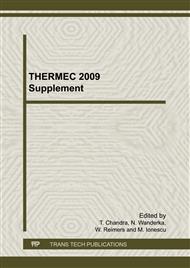p.17
p.23
p.29
p.35
p.41
p.47
p.53
p.59
p.65
Effect of High Pressure Torsion on Crystal Orientation to Improve the Thermoelectric Property of a Bi2Te3-Based Thermoelectric Semiconductor
Abstract:
A Bi2Te3-based thermoelectric semiconductor was subjected by high pressure torsion (HPT). Sample disks of p-type Bi0.5Sb1.5Te3.0 were cut from sintered compacts that were made by mechanically alloying (MA) followed by hot pressing. Disks were subjected by HPT with 1, 5 and 10 turns at 473 K under 6.0 GPa of pressure. Crystal orientation was investigated by X-ray diffraction. Microstructures were characterized using scanning electron microscopy. Results indicated that HPT disks after 5 turns had a preferred orientation and a fine grain compared with pre-HPT disks while the orientation factor was decreased after HPT using 10 turns. The power factor had a maximum value at 5 turns as determined by measuring its thermoelectric properties. A maximum power factor of 4.30×10-3 Wm-1K-2 was obtained for HPT disks after 5 turns. This value was larger than that for the pre-HPT disk. The over-HPT of 10 turns was found to have caused a decrease in the preferred orientation leading to a low power factor.
Info:
Periodical:
Pages:
41-46
Citation:
Online since:
January 2010
Price:
Сopyright:
© 2010 Trans Tech Publications Ltd. All Rights Reserved
Share:
Citation:


